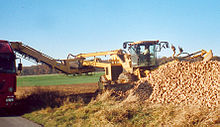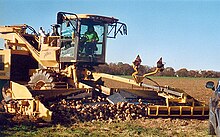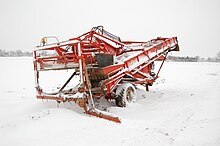Beet cleaning loader
A beet cleaning loader (RRL). is an agricultural machine used for cleaning and loading beets, especially sugar beets . The name beet mouse from one of its manufacturers characterizes its possible uses and stands as MAUS for M = rent, A = pick-up, U = reloading and S = system. At harvest with a beet loader cleaning the beets are by a beet harvester cleared and in long Rent deposited at the field edge. The beets stored in the rent can be freed from adhering earth in one operation with the help of a cleaning loader and loaded onto a truck or tractor trailer for transport to the sugar factory using a transfer conveyor.
Basically, a distinction is made between two different types of cleaning loaders: on the one hand, stationary, non-self-loading (beet-picking) beet cleaning loaders, on the other hand, self-propelled and self-loading loaders.
Working method
The following operations are carried out one after the other:
- Picking up the beets from the beet heap
- Cleaning the remains of the earth from the sugar beet
- Overloaded on transport vehicle
Classification
Beet cleaning loaders are divided into:
- Self-propelled beet cleaning loaders and
- Stationary beet cleaning loader.
Self-propelled beet cleaning loaders
Beet pickup
The intake (also called the intake table) consists either of sieve belts or, in modern machines, of rollers rotating transversely to the vehicle axis.
The first roller runs halfway in the ground and is equipped with "fingers" for better picking up of the beets. These run between the thick disks of the second roller (cleaner roller). Further rollers then follow to clean the beets and transport them to the center of the vehicle. With some systems, the cleaning path is extended by guiding the beet flow over the entire width of the intake. Rollers first transport the sugar beets to the outside of the intake and later in the rear part of the intake again to the center of the vehicle. Arrived in the middle, the beets are transferred to a sieve belt, called a waist belt or central belt. In the direction of travel in front of the waist belt there are either rollers (mounted lengthways) or a central point for dividing the rent. The recording, depending on the type, is between 8 and 10 meters wide. In order to be able to drive on public roads, the holder can be folded in on the right and left. If the driver's field of vision is restricted when the table is folded, an escort vehicle must be used for journeys on public roads.
- Fold in the beet pick-up for road travel
cleaning
- Waist belt:
- With RRL, the waist belt or middle belt is a sieve belt . This consists of two rubberized fabric straps that are connected with round steel rods. The central belt transports the beets between the front wheels and under the driver's cab through to the rear to a post- cleaner or pinch roller cleaner . In order to safely transport all beets on the given incline, some of the sieve belt rods are equipped with driver fingers .
- Post-cleaner and pinch roller cleaner
- The post-cleaner is a simple sieve belt. Cleaning is carried out on the basis of the fall steps between the waist belt, post-cleaner and overloader.
- The pinch roller cleaner consists of several screw rollers that are paired in opposite directions. While the auger winds continue to transport the beets, the opposite rotation ensures that the unwanted components (grass and cabbage) are extracted.
Loader The loader is a swiveling, height-adjustable boom with a sieve belt. The possible transfer widths range from 11.50 m to 13 m measured from the center of the charger to the center of the transport vehicle. The loading height can be adapted to the circumstances so that, for example, in the event of greater height differences, for example if the transport vehicle has high tail lifts and is also higher than the loading mouse, loading can still take place. The maximum loading height is therefore around 6 meters with the maximum loading width. The driver can operate the truck conveyor via a joystick. In order to adapt to the conditions in the field, it is possible to overload to the right and left. The boom is folded in for road travel.
Scales With the help of a continuous scale, the weight of the loaded sugar beets can be determined during the loading process on some models. So-called load cells are used for the measurement . The theoretical weight is determined by taking into account the loading speed, power requirement and force measured value of the load cells. In order to take the changing conditions (e.g. wet or dry beets) into account, these data are compared with comparative values. To do this, the loaded truck must be weighed in the sugar factory. The scales are then recalibrated using the difference between the two measured values (beet cleaning loader and sugar factory).
Balance weight and axle support If the truck conveyor is swiveled into the working position, i.e. in a large display, and if it is loaded by the beet during loading, a balance weight is necessary for static reasons. This prevents the machine from tipping over. Most manufacturers mount the weight on a joint under the pivot point of the truck conveyor and swing it opposite to the boom. Other constructions use displaceable or pivotable counterweights that act directly at the pivot point of the boom. A combination of counterweight, diesel tank and / or water tank are common.
There is also a hydraulic axle support. With this slope compensation , two hydraulic cylinders support one or more pivoting axles at the side.
Residual beet pick-up The residual beet pick-up is used to collect isolated beets (remaining beets from the almost completely removed pile). On a hydraulically pivoting arm there is either a rotating rubber ball fitted with drivers or a rubber plate similar to a scraper blade. With this, the beets are rolled or scratched onto the receptacle.
Stationary beet cleaning loaders
Stationary RRL are mostly trailer vehicles that are equipped with a bunker, a cleaning device and an overloader. The beets must be picked up and the bunker filled using separate machines, e.g. wheel loaders. Scraper bars in the bunker continuously convey the beets to the cleaning section. Similar to the self-loading version, this consists of main belts and spiral rollers, but can also consist of a large screen star. The transfer conveyor is comparatively short at around 8 meters.
The moving parts of stationary RRLs are hydraulically driven by their own diesel engine. In older models, the drive was via the PTO shaft of a tractor. The loading belts are operated using levers directly on the machine. Newer models have a radio remote control so that the farmer no longer needs to get off the loading vehicle to control the cleaning loader.
Performance data
The loading capacities of modern beet loaders are around 170 t / h for stationary devices and between 329 t / h and 547 t / h for self-loaders. The performance values depend on the condition of the rent and the efficiency of the removal logistics.
The quality of the loaded beets depends on the amount of soil they contain and the loss of broken roots. The values are given in percent and should ideally be zero. In practice, however, values between 6.3 and 3.4 percent for the earth fraction and 4.2 to 3.3 percent for the root breakage are achieved. In this respect, the earth portion of the rent and the type of cleaning loader used are decisive for the result. If the soil content is high, the beets are loaded more gently, but may not be cleaned as well.
history
Haulier Erich Fischer from Eggmühl (Schierling) in Upper Palatinate is considered to be the inventor of the self-propelled beet cleaning loader . On May 12, 1982, Fischer registered a patent with the title “Self-propelled loading and cleaning device, especially for sugar beets” . But he was already testing his invention in the field in the 1960s. During these tests, the machine was not able to collect all the beets. The remaining sugar beets were thrown onto the conveyor belts by the farmers with beet forks . The mice fleeing from the beet heap ran in front of the farmers' feet. Your Bavarian exclamation "Do is a mouse" is said to be responsible for the naming of the Fischer-Maus .
Fischer's mouse from 1982 already showed technical details that can still be found at RRL's today. This includes a wide, foldable holder, a waist belt running between the front axle, a post-cleaner and the truck conveyor.
The side parts of the mounting were hydraulically folded up in front of the cab in order to achieve the required width for road travel. However, the view to the front at an angle was severely restricted. The recording consisted exclusively of sieve belts. Each pick-up side part consisted of a sieve belt with arched driver prongs that was conveying backwards and upwards in the direction of travel. For this purpose, another sieve belt transversely behind this, each conveying to the center of the vehicle on the belt. As part of the recording, the waist belt extends to the lower front edge of the side panels. The further beet conveying route went under the cabin and along the engine to the rear on a short intermediate belt and from there to the rotating truck conveyor.
Some of the parts came from other machines. The cabin and frame parts were taken over from an old Bleinroth beet harvester. A Mercedes-Benz engine with 6 cylinders and 180 hp was placed in the center of the main frame . The diesel engine was the drive for several hydraulic pumps. The pick-up and truck conveyor were moved with the aid of hydraulic cylinders. Hydraulic motors provided the drive for the conveyor belts. The gearbox, connected to the front and rear axles via cardan shafts, was also hydraulically driven. This made it possible to continuously adjust the speed within a gear step.
The mouse was 12.50 m × 3.0 m × 3.65 m (L × W × H) and weighed about 13 t. The loading capacity was given as around 150 t / h. According to his own statement, Fischer wants to have loaded around 2 million tons with his mouse .
In 1987 Hermann Paintner, who a year earlier co-founded the company ROPA , bought the patent from Fischer. Paintner and his employees improved the machine, among other things, with a larger pick-up, a longer loader and a counterweight for this. The name Maus was adopted for the series machine. The type of intake with sieve chains has also been retained. It was not until the years between 1992 and 1996 that this system was gradually abandoned. First the transversely conveying belts were replaced by spiral rollers. In 1996 the first complete roll holder was available.
But fishermen and painters weren't the only ones to dig deeper into the technology of beet loading. An Alfons Holmer (also from Eggmühl) and a Wilhelm Pfeiffer from Bad Soden am Taunus received patents for similar machines in 1988. Alfons Holmer also built some prototypes, including with crawler tracks or with a telescopic cab. However, these machines never went into series production. It was not until 2007, after the takeover of Bottmersdorfer Gerätebau ("gebo") , that Holmer Maschinenbau also built self-propelled beet cleaning loaders.
The company Unsinn from Aichach ( note: not to be confused with Unsinn Fahrzeugtechnik in Holzheim ) also built self-propelled beet loaders , among other things . From 1994, production was taken over by Salzkottener Maschinenbau ( "Kleine" ), the machine was further developed and further built as the Kleine RL 200. Even after the Grimme Group took over the company, the machines are sold under the Kleine brand name .
Individual evidence
- ↑ a b c d e Four cleaning loaders in comparison. In: Profi. 1/2007.
- ↑ Gottfried Eikel: The cat in the mouse fur. In: Profi. 3/2003, pp. 38-40.
- ↑ ropa-maschinenbau.de - Technical data euro-Maus 4 section " Recording system " (accessed on July 3, 2017)
- ↑ a b Peter Schulze, Lammers, Oliver Schmittmann, Christian Peveling, Klaus Ziegler: Rodertest in Seligenstadt 2012. (PDF; 948 kB). on: liz-online.de (accessed on July 3, 2017)
- ↑ dpma.de - Patent DE000003217889A1, p. 22 (accessed on July 11, 2017)
- ↑ a b mtu-report.com - MTU-Report, Katrin Beck: "From tigers and mice" (accessed on July 10, 2017)
- ↑ dpma.de - Patent: DE000003401661A1, p. 20 (accessed on July 18, 2017)
- ↑ dpma.de - Patent: DE000008809672U1, p. 26 (accessed on July 18, 2017)









